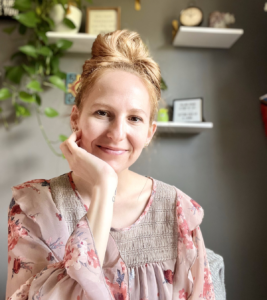
When it comes to setting boundaries, Brené Brown said it best:
“Compassionate people ask for what they need. They say no when they need to, and when they say yes, they mean it. They’re compassionate because boundaries keep them out of resentment.”
Did anyone else hear that mic drop?!? If you did (and it was loud) perhaps it resonates because your struggling with setting boundaries and your emotions are what’s getting in the way…
Guilt and Blame and SHAME, oh my!
In my clinical and personal experience, uncomfortable and sometimes overwhelming feelings, such as guilt, is the #1 reason people avoid setting boundaries and especially saying “no.” EVEN WHEN THERE’S EVIDENCE TO SUGGEST THE OTHER PERSON WILL ACCEPT THE NO, many people still say “yes” when they don’t want to.
There are many individual reasons and human complexities why this happens, but a primary explanation is rooted in our core beliefs. Core beliefs are solidified narratives we hold about ourselves, other people and the world (sometimes also referred to as our world view).
Some examples of common core beliefs would be that most people are inherently well-intentioned, giving and kind or ill-intentioned, selfish and untrustworthy. Another example could be the belief that we ourselves are failures if we fail or that we are still capable, despite our mistakes and short-comings.
When it comes to boundary setting (which is rooted in core beliefs that support self-respect), there are many common core beliefs that can stand in people’s way, like:
- Saying no is selfish and mean
- Being a good person means doing things I don’t like doing
- Doing things I don’t want to is a sign of strength and willpower
- People won’t like me/will get angry with me/judge me… if I say no
- If you truly love someone, boundaries should not be necessary
The thing about core beliefs, is that we aren’t born with them, we are taught them. So if any of those examples resonate with you, they were likely introduced and repeated by influential people in your life (e.g.: family, peers, teachers, religious leaders, etc.) until they eventually solidified deep inside you.
The other thing about core beliefs that is important to understand, it that they significantly influence our emotional states. Many of the core beliefs listed above can be directly linked to feelings of guilt (“I did something bad“), shame (“I am bad“) and blame (“it’s all my fault“).
When our emotions run the show
When we become overwhelmed with emotions like these, they have a tendency to take over and run the show. By that, I mean to that our more extreme emotional parts are take charge of making our decisions. Understandably, those extreme emotional parts are only focused on returning us to a state in which we feel safe (but not necessarily respected).
The behavioral consequence is often to please, appease, avoid, and self-sacrifice. This approach (as you probably know) will often temporarily alleviate your distress successfully, but also keep you stuck in unhealthy relationship dynamics with others, long-term. This often looks like:
- Taking responsibility inappropriately (carrying unnecessary burden and blame)
- Feeling resentful of those who need you (even the people we love the most!)
- Becoming annoyed with those who ask things of you (we porcupine in the hopes people will learn to stop asking)
- Use passive-aggression to communicate your true feelings (which damages relationships)
- People learn not to trust you (they never know if your yes is sincere)
- People learn to manipulate you (take the yes and run – they don’t care if your yes is sincere!)
And this is often where we find ourselves. Feel stuck, unhappy in our relationships, and probably googling “how to say no when it triggers guilt?” But this can change!
Don't let guilt stop you
So how do you learn to say no and ask for what you need, without letting guilt stop you? Listed below are 4 strategies I offer my clients to help them do just that!
But there is one thing you need to know first: We won’t be getting rid of guilt (or any of those other emotions). Let that sink in, because to be successful here, expectations will need to change.

Why? Because we can’t completely control our internal experiences (i.e.: thoughts, emotions, sensations) and trying to makes them more intense and last longer. If you need more help adjusting to this perspective, check out this TEDx Talk given by Acceptance and Commitment Therapy originator, Steven Hayes on the importance of psychological flexibility for change.
If you’re curious and ready to learn about my strategies for how to cope better with feelings of guilt so that you can say no when you need to and say yes when you mean it – keep reading!
3 Strategies for saying no (even when you feel guilty!)
Here are three specific strategies that I use with all my clients to help them say no, even when they feel guilty about it:
- Get clear on your values
Personal values are guiding principals that help us make meaningful choices in our lives. Explore and identify your most important values and use them as a “compass” for how and when to set effective boundaries (like saying no).
For example, If one of your top values is Respect (specifically mutual respect), you might say no to an invitation to spend time with someone who you feel uncomfortable around, by responding early, expressing appreciation for the invitation and wishing them a good time in your absence.
Here you’re practicing self-respect by not making yourself spend time with people who you don’t want to. You’re also practicing other respect by responding in a timely manner, expressing appreciation, and declining clearly but kindly.
- Differentiating helpful guilt vs. unhelpful guilt
Guilt is a natural and necessary emotion. Its purpose is to let us know when we have made a mistake, when our behavior is problematic in some way. Ideally, the feeling prompts us to re-evaluate our behavior and take necessary actions to repair the situation. that might look like apologizing, committing to making an effort to change, and acknowledging our misstep.
This experience of guilt is helpful, manageable to feel and actually serves the health of our relationships.
Unhelpful guilt is different.
Unhelpful guilt does not allow for mistakes. It expects perfection (of ourselves and others), which is of course impossible and, therefore, causes us a great deal of distress.
This is often the guilt that feels unmanageable to cope with, primarily because it carries an air of shame. It frames us as being bad, or a failure, or some other label that blankets us as a whole. This is the opposite of helpful guilt, which recognizes that behaviors are things we do, not who we are. Behaviors can always be changed (and that offers us hope), but how do we go about not “being bad” anymore?
Observing and differentiating when your guilt is helpful (or not), will help you determine what to do next. Helpful guilt prompts us to make change. But what about the unhelpful guilt that drives us to act against our values and relationships…?
- Consider what to Change and what to Accept
There are many things out of our control in this world (I know you know this). What we don’t often know, however, is how to determine where to expend our energy for making changes and choices about things like boundary setting and emotional coping.
Here are some options for change to consider, when it comes to following through with more effective boundary setting:
- Delay responding to requests to avoid compulsively saying yes! Wait an hour or until the end of the day to give yourself time to do something different.
- Write out what you want/need to say first and make edits until it is something you can stand by (i.e.: reflects those values we discussed earlier) – even if the other person doesn’t like your answer.
- Text or email instead of saying no face to face. This can reduce the pressure (and often the intensity of emotional triggers). This is a great strategy for working your way up to F2F interactions.
- Practice grounding exercises, mindfulness and therapeutic breathing to help you experience and cope with the feelings that arise.
Conversely, here are some things you might want to consider accepting (actively not trying to change), in order to reserve your energy and become more psychologically flexible:
- Accept all the feelings. Remember, if we try to get rid of them, they often feel more intense and hang around for longer periods of time. That’s not to say we cannot influence our feelings, because we can (e.g.: the change list above)! But if we are practicing acceptance, the idea is to increase our willingness to allow what is.
- Accepting that growth and change comes with uncomfortable, some times intense, feelings.
- Accept that progress takes time and while feelings, like guilt, will become more manageable with practice, there is no way to know when it will get easier.
- Accept that feelings of confidence and motivation come AFTER doing the hard things – not before.
In sum
So here’s the deal: If you are not used to saying no or asking for what you need in life, it will feel all kinds of wrong in the beginning. But, just as with any new skill, the more you practice it, the easier it will be to follow through (even when it feels uncomfortable). The key is to let your personal values guide you.
If you practice saying no in a respectful and concise way, you will be teaching others how you want to be treated. As a result, resentment can begin to fade, confidence builds, connections deepen and our relationships start to feel safer, and much more authentic.


Katie Bingner, MS, LCPC, is a integrative trauma-informed psychotherapist and communication coach, who’s spent the past 16 years in the health and wellness industry. Katie has dedicated the past 8+ years to helping others (and herself) navigate mental health challenges, Learn the skills of connection, live and embrace our shared humanness.
For more information or to schedule a consultation, click below.
